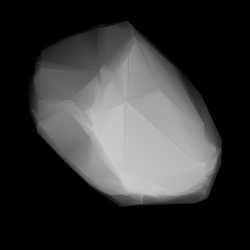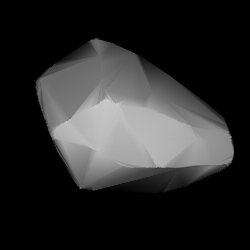789 Lena, provisional designation 1914 UU, is a metallic asteroid from the middle region of the asteroid belt, approximately 24 kilometers in diameter. It was discovered on 24 June 1914, by Soviet–Russian astronomer Grigory Neujmin at Simeiz Observatory on the Crimean peninsula, and named after the discoverer's mother.
Arago, provisional designation 1923 OT, is a dark asteroid from the outer regions of the asteroid belt, approximately 55 kilometers in diameter. It was discovered on 5 September 1923, by Russian astronomer Sergey Belyavsky at the Simeiz Observatory on the Crimean peninsula. The asteroid was named after French mathematician François Arago.
Pawlowia, provisional designation 1923 OX, is a background asteroid from the central regions of the asteroid belt, approximately 20 kilometers in diameter. It was discovered on 5 October 1923, by Soviet astronomer Vladimir Albitsky at the Simeiz Observatory on the Crimean peninsula. The asteroid was named after Russian physiologist and Nobelist Ivan Pavlov.

1135 Colchis ; prov. designation: 1929 TA) is a background asteroid from the central region of the asteroid belt. It was discovered on 3 October 1929, by Soviet astronomer Grigory Neujmin at the Simeiz Observatory on the Crimean peninsula. The X-type asteroid has a rotation period of hours 23.5 and measures approximately 49 kilometers in diameter. It was named for the ancient Kingdom of Colchis.

1110 Jaroslawa is a bright background asteroid and rather slow rotator from the inner regions of the asteroid belt. The stony S-type asteroid has a rotation period of 97.4 hours and measures approximately 13 kilometers in diameter. It was discovered at the Simeiz Observatory on the Crimean peninsula on 10 August 1928, by astronomer Soviet Grigory Neujmin, who named it after his son, Jaroslav Grigorevich Neujmin.

1118 Hanskya is a large background asteroid, approximately 77 kilometers in diameter, located in the outer regions of the asteroid belt. Discovered by Sergey Belyavsky and Nikolaj Ivanov in 1927, it was named after Russian astronomer Aleksey Hansky. The presumed dark C-type asteroid has a rotation period of 15.6 hours.
1120 Cannonia, provisional designation 1928 RV, is a stony Florian asteroid from the inner regions of the asteroid belt, approximately 10 kilometers in diameter. Discovered by Pelageya Shajn at Simeiz in 1928, it was named after American astronomer Annie Jump Cannon.
1123 Shapleya, provisional designation 1928 ST, is a stony Florian asteroid from the inner regions of the asteroid belt, approximately 11 kilometers in diameter. It was discovered on 21 September 1928, by Russian astronomer Grigory Neujmin at Simeiz Observatory on the Crimean peninsula. It was named after American astronomer Harlow Shapley.

1137 Raïssa is a stony background asteroid and slow rotator, approximately 22 kilometers in diameter, located in the inner regions of the asteroid belt. It was discovered by Grigory Neujmin at Simeiz Observatory in 1929, and named in memory of Raïssa Maseeva, who worked at the Pulkovo Observatory.

1140 Crimea, provisional designation 1929 YC, is a stony asteroid from the middle region of the asteroid belt, approximately 28 kilometers in diameter. It was discovered on 30 December 1929, by Soviet astronomer Grigory Neujmin at Simeiz Observatory on the Crimean peninsula, after which it was named.

1147 Stavropolis is a stony background asteroid from the inner regions of the asteroid belt. It was discovered on 11 June 1929, by Georgian–Russian astronomer Grigory Neujmin at the Simeiz Observatory on the Crimean peninsula. The S-type asteroid has a rotation period of 5.7 hours and measures approximately 14 kilometers in diameter. It was named after the Russian city of Stavropol.
1309 Hyperborea is a carbonaceous background asteroid from the outermost regions of the asteroid belt, approximately 57 kilometers in diameter. It was discovered on 11 October 1931, by Soviet astronomer Grigory Neujmin at the Simeiz Observatory on the Crimean peninsula, and given the provisional designation 1931 TO. The asteroid was named after Hyperborea, the northern homeland of a Greek mythical race of giants.
1271 Isergina, provisional designation 1931 TN, is a carbonaceous background asteroid from the outer regions of the asteroid belt, approximately 45 kilometers in diameter. It was discovered on 10 October 1931, by Soviet astronomer Grigory Neujmin at the Simeiz Observatory on the Crimean peninsula. The asteroid was named after Crimean physician and friend of the discoverer, Pyotr Isergin.
1347 Patria, provisional designation 1931 VW, is a carbonaceous asteroid from the background population of the central asteroid belt, approximately 32 kilometers in diameter. It was discovered on 6 November 1931, by Soviet astronomer Grigory Neujmin at the Simeiz Observatory on the Crimean peninsula. The asteroid was named for the Latin word of fatherland.
1306 Scythia, provisional designation 1930 OB, is a dark Ursula asteroid from the outer regions of the asteroid belt, approximately 72 kilometers in diameter. It was discovered on 22 July 1930, by Soviet astronomer Grigory Neujmin at the Simeiz Observatory on the Crimean peninsula. The asteroid was named for the historic region of Scythia.
1692 Subbotina, provisional designation 1936 QD, is a dark background asteroid from the central region of the asteroid belt, approximately 37 kilometers in diameter. The carbonaceous Cg-type asteroid has a rotation period of 9.2 hours. It was discovered by Grigory Neujmin at the Crimean Simeiz Observatory in 1936, and later named after Soviet mathematician and astronomer Mikhail Subbotin.

1189 Terentia, provisional designation 1930 SG, is a carbonaceous Terentian asteroid from the outer regions of the asteroid belt, approximately 56 kilometers in diameter and the namesake of its family. The asteroid was discovered by Russian astronomer Grigory Neujmin at Simeiz Observatory on 17 September 1930.
1266 Tone is a dark background asteroid from the outer regions of the asteroid belt, approximately 80 kilometers in diameter. Discovered by astronomer Okuro Oikawa at the Tokyo Observatory in 1927, it was assigned the provisional designation 1927 BD. The asteroid was later named after the Tone River, one of Japan's largest rivers.
1734 Zhongolovich, provisional designation 1928 TJ, is a carbonaceous Dorian asteroid from the central region of the asteroid belt, approximately 28 kilometers in diameter.

1289 Kutaïssi is a stony Koronian asteroid from the outer region of the asteroid belt. Discovered by Grigory Neujmin at Simeiz Observatory in 1933, it was later named after the Georgian city of Kutaisi. The S-type asteroid has a rotation period of 3.6 hours and measures approximately 22 kilometers in diameter.








